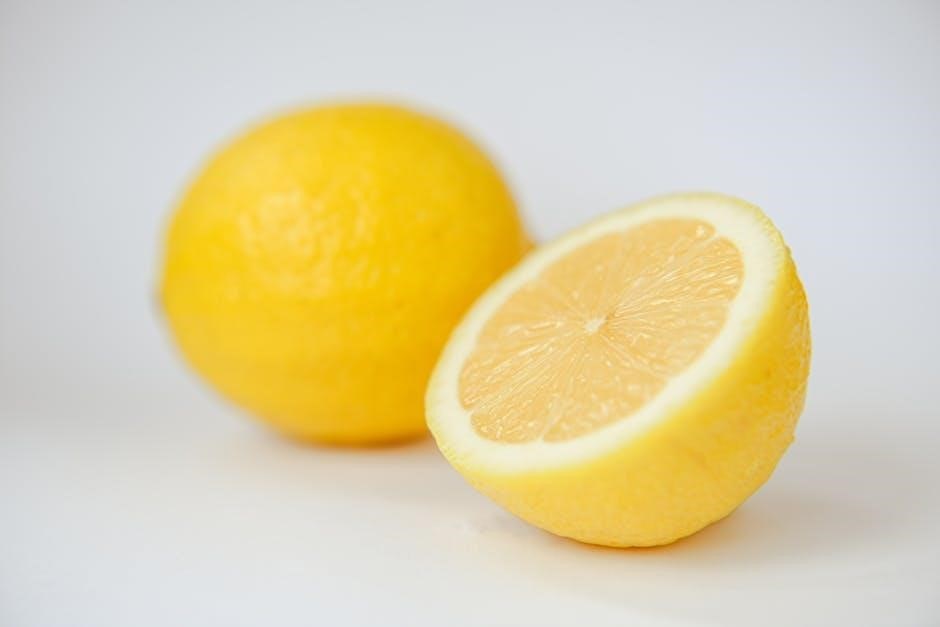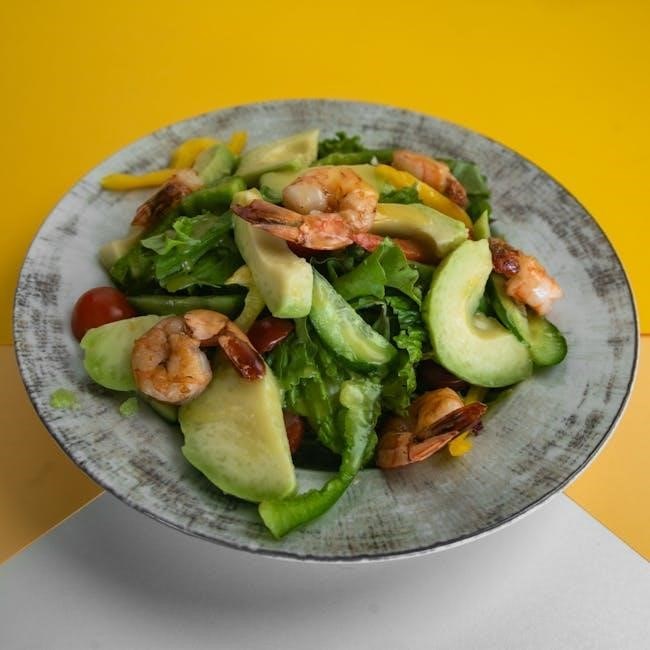An acid reflux diet is a dietary approach to managing symptoms by reducing stomach acid production and preventing heartburn through specific food choices and portion control;
What is Acid Reflux and How Does Diet Impact It?
Acid reflux, or gastroesophageal reflux disease (GERD), occurs when stomach acid flows back into the esophagus, causing discomfort. Diet plays a crucial role in managing symptoms, as certain foods trigger acid production while others alleviate it. Foods like citrus fruits, tomatoes, chocolate, and processed items can worsen reflux by relaxing the lower esophageal sphincter or increasing stomach acid. Conversely, alkaline foods, low-acid fruits, and high-fiber options help neutralize acid and improve digestion. A tailored diet plan, such as the Acid Watchers Diet or GERD-specific plans, can significantly reduce symptoms and prevent complications. Experts like Dr. Jamie Koufman emphasize the importance of dietary adjustments for long-term relief.
The Importance of a Tailored Diet Plan for Managing Symptoms
A personalized diet plan is essential for effectively managing acid reflux symptoms. By identifying and avoiding trigger foods, individuals can significantly reduce heartburn and discomfort. A tailored approach ensures that meals are balanced, nutritious, and easy to digest, preventing acid production spikes. Incorporating low-acid fruits, vegetables, and high-fiber foods helps maintain a healthy digestive system. Additionally, portion control and meal timing play a crucial role in alleviating symptoms. Experts, like Dr. Jamie Koufman, recommend customized diets to address individual needs, promoting long-term relief and improving overall well-being. This targeted strategy not only reduces inflammation but also enhances quality of life for those with GERD.

Best Foods to Include in an Acid Reflux Diet
Incorporate non-trigger, alkaline-rich foods like lean proteins, whole grains, and non-acidic vegetables to reduce inflammation and support digestion, aiding in symptom relief for GERD sufferers.
Alkaline Foods: Their Role in Reducing Stomach Acid
Alkaline foods, such as green vegetables, lean proteins, and whole grains, help neutralize stomach acid by balancing pH levels, reducing inflammation, and promoting a healthier digestive environment. These foods, often with a higher pH level, counteract acidity and alleviate heartburn symptoms. Incorporating alkaline-rich options like spinach, almonds, and oatmeal can significantly reduce reflux episodes. They are also low in triggers and high in fiber, which supports digestion and prevents overeating. By focusing on these foods, individuals can create a diet that not only manages symptoms but also enhances overall well-being, aligning with recommendations from experts like Dr. Jamie Koufman and Johns Hopkins Medicine.
Low-Acid Fruits and Vegetables: Safe Choices for Reflux Sufferers
Low-acid fruits and vegetables are essential for managing acid reflux, as they minimize stomach acid production and reduce irritation. Options like bananas, apples, and melons are excellent choices, while vegetables such as cucumbers, carrots, and broccoli are also beneficial. These foods are naturally low in acidity and high in fiber, which aids digestion and prevents overeating. Incorporating these into meals helps balance the diet and alleviate symptoms. They are also rich in essential nutrients, making them a healthy and sustainable option for long-term reflux management, as recommended by experts like Dr. Jamie Koufman and Johns Hopkins Medicine.
High-Fiber Foods: How They Support Digestive Health
High-fiber foods play a crucial role in supporting digestive health for acid reflux sufferers. They help absorb excess stomach acid, improve gastric motility, and prevent reflux by promoting regular bowel movements. Whole grains like oatmeal, barley, and quinoa are excellent choices, as are legumes such as lentils and beans. Non-citrus fruits like apples and pears, as well as vegetables like broccoli and carrots, are also high in fiber and gentle on the stomach. Incorporating these foods into meals can help regulate digestion and reduce symptoms. Experts, including Dr. Jamie Koufman, recommend increasing fiber intake to support long-term reflux management and overall digestive well-being.
Foods to Avoid in an Acid Reflux Diet
Certain foods can trigger acid reflux by relaxing the lower esophageal sphincter or increasing stomach acid production, worsening symptoms like heartburn and discomfort.
Common Trigger Foods: Citrus Fruits, Tomatoes, and Chocolate
Citrus fruits, like oranges and lemons, are highly acidic and can relax the lower esophageal sphincter, allowing stomach acid to flow back up. Tomatoes and tomato-based products are also acidic, making them common triggers. Chocolate contains caffeine and other compounds that can weaken the sphincter and increase acid production. These foods are often avoided in GERD-friendly diets to reduce symptoms. Understanding and identifying personal triggers is key to managing acid reflux effectively through dietary changes.
Processed and Fried Foods: Why They Exacerbate Symptoms
Processed and fried foods are high in unhealthy fats, which slow digestion and increase pressure on the lower esophageal sphincter, making acid reflux worse. Fried foods, in particular, are difficult to digest and can delay gastric emptying, allowing stomach acid to flow back into the esophagus. Processed foods often contain additives and spices that can irritate the esophagus and trigger symptoms. Reducing or eliminating these foods from the diet can significantly reduce reflux episodes and improve overall digestive health. Opting for lean, non-fried alternatives is a key step in managing acid reflux effectively.
Caffeine and Alcohol: Their Impact on Acid Production
Caffeine and alcohol are known to relax the lower esophageal sphincter, allowing stomach acid to flow back into the esophagus, worsening reflux symptoms. Caffeine, found in coffee, tea, and energy drinks, can also stimulate acid production in the stomach. Alcohol, particularly in large amounts, irritates the esophagus and delays digestion, further exacerbating discomfort. Both substances can weaken the sphincter’s function over time, making reflux more frequent and severe. Reducing or eliminating caffeine and alcohol from the diet can significantly improve symptoms and support long-term management of acid reflux. Moderation is key, but complete avoidance is often recommended for severe cases.

7-Day GERD Diet Plan for Rapid Relief
A structured 7-day plan providing breakfast, lunch, and dinner ideas, plus snacks, to alleviate acid reflux symptoms and promote digestive health, as recommended by nutrition experts.
Breakfast, Lunch, and Dinner Ideas for Each Day
A 7-day GERD diet plan offers structured meal ideas to alleviate symptoms. Breakfast options include oatmeal with almond butter or scrambled eggs with spinach. Lunches might feature grilled chicken with quinoa and steamed vegetables, while dinners could consist of baked fish with sweet potatoes and green beans. Snacks like celery sticks or non-citrus fruits are recommended. Beverages such as ginger tea or water with lemon slices can aid digestion. Each meal focuses on portion control, avoiding trigger foods, and incorporating alkaline and low-acid ingredients to reduce acid production and promote healing. This plan ensures balanced nutrition while managing GERD effectively.
Snacks and Beverages That Alleviate Symptoms
Snacks like bananas, melons, and cucumber slices are excellent for reducing reflux symptoms. Beverages such as water, herbal teas, and almond milk are also beneficial. Avoiding citrus fruits and caffeine is crucial, as they can trigger acid production. Incorporating ginger-infused water or non-acidic smoothies can help neutralize stomach acid. Snacks high in fiber, like apples or carrots, promote digestion and prevent heartburn. Staying hydrated and choosing snacks low in acidity and fat can significantly alleviate symptoms. Opting for small, frequent portions of these snacks and beverages helps manage reflux effectively throughout the day without overloading the digestive system.

Specialized Diets for Acid Reflux
Dr. Koufman’s Acid Reflux Diet and the Acid Watchers Diet are tailored approaches to managing symptoms. Both emphasize non-acidic foods, portion control, and avoiding trigger items for relief.
The Acid Watchers Diet: Principles and Benefits
The Acid Watchers Diet focuses on reducing acid intake by eliminating trigger foods. It emphasizes non-acidic foods, portion control, and mindful eating. Beneficial for GERD sufferers, it helps alleviate symptoms by minimizing esophageal irritation. The diet promotes meal timing and balanced nutrition, supporting long-term healing. Its principles align with other reflux-friendly plans, offering flexibility for individual needs. Many find it effective for sustained relief and improved digestive health.
Vegan and Gluten-Free Options for Reflux Management
Vegan and gluten-free diets can be highly effective for managing acid reflux by eliminating common triggers. Plant-based foods like leafy greens, non-citrus fruits, and vegetables are naturally low in acid. Gluten-free options such as quinoa, rice, and millet are also beneficial. These diets reduce inflammation and promote a balanced digestive system. Many vegan and gluten-free recipes avoid dairy and processed ingredients, which are known to exacerbate reflux. Incorporating alkaline-rich foods like almonds and cucumbers further supports symptom relief. For those with dietary restrictions, these options provide a flexible and sustainable way to manage reflux while maintaining nutritional balance and overall health.

Lifestyle Modifications to Enhance the Diet Plan
Portion control, smaller meals, and avoiding late-night eating can reduce symptoms. Elevating the head during sleep and staying upright after meals further aids digestion and prevents acid flow.
Portion Control, Eating Frequency, and Meal Timing
Managing portion sizes and eating smaller, more frequent meals can significantly reduce acid reflux symptoms. Avoiding heavy meals close to bedtime is crucial, as lying down after eating exacerbates reflux. Eating earlier in the evening allows the stomach to partially empty before reclining, minimizing acid backflow. Additionally, spacing meals evenly throughout the day helps maintain steady digestion and prevents overloading the stomach, which can trigger heartburn. These simple adjustments in eating habits, combined with a tailored diet, create a comprehensive approach to managing GERD and improving overall digestive health effectively.
Exercise and Weight Management: Their Role in Reducing Reflux
Regular exercise and maintaining a healthy weight are essential for managing acid reflux. Excess weight, particularly around the abdomen, can increase pressure on the stomach, promoting acid reflux. Engaging in moderate physical activity, such as walking or yoga, improves digestion and strengthens abdominal muscles, reducing symptoms. However, high-intensity exercises should be avoided immediately after meals. Weight management through a combination of diet and exercise can significantly alleviate reflux by reducing intra-abdominal pressure and improving overall digestive function. Pairing these lifestyle changes with a tailored diet creates a holistic approach to long-term reflux relief and better overall health.
Adhering to an acid reflux diet effectively reduces symptoms, prevents complications, and enhances overall well-being. It involves dietary strategies like avoiding trigger foods, incorporating alkaline-rich options, and mindful eating. Sustained commitment leads to lasting relief and improved quality of life.
Long-Term Benefits of Adhering to an Acid Reflux Diet
Adhering to an acid reflux diet offers numerous long-term benefits, including reduced inflammation, healing of the esophagus, and prevention of complications like esophageal damage or narrowing. It decreases reliance on medications, improves digestion, and minimizes symptom recurrence. Over time, a tailored diet helps maintain a healthy weight, lowers the risk of chronic conditions, and enhances overall well-being. Consistency fosters sustainable lifestyle changes, promoting better eating habits and a balanced relationship with food. By addressing the root causes of reflux, this diet provides lasting relief and improves quality of life, making it a vital component of long-term health management.
Final Tips for Sustaining a Reflux-Friendly Lifestyle
Sustaining a reflux-friendly lifestyle requires commitment and mindful habits. Start by maintaining a food diary to track triggers and identify patterns. Gradually incorporate reflux-friendly foods while eliminating triggers. Practice portion control and eat smaller, frequent meals to avoid overwhelming the digestive system. Stay hydrated by drinking water between meals, but avoid fluids during meals to prevent bloating. Incorporate light exercise, like walking, after meals to aid digestion. Lastly, consult with a healthcare provider or dietitian to personalize your plan and address any challenges. By combining these strategies, you can maintain long-term relief and enjoy a healthier, symptom-free life.